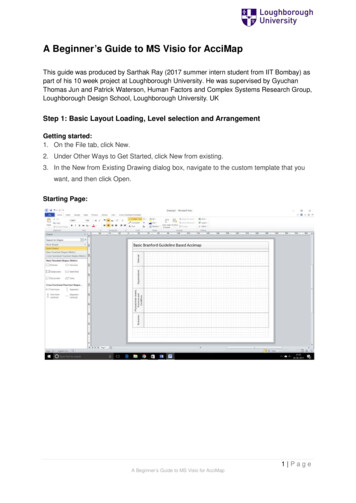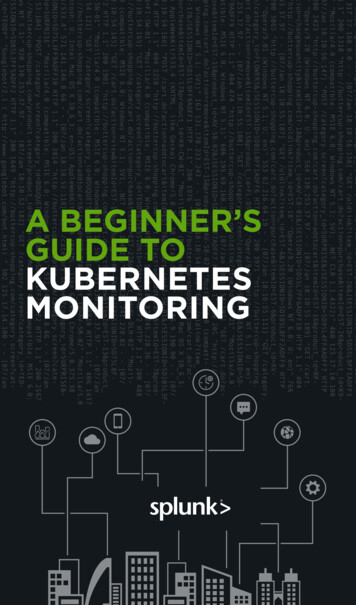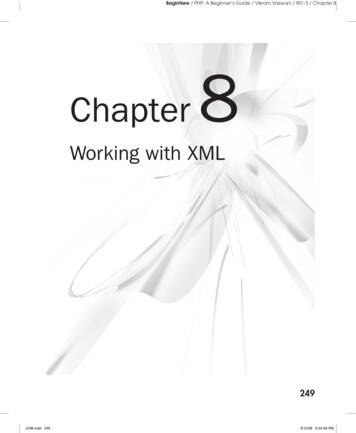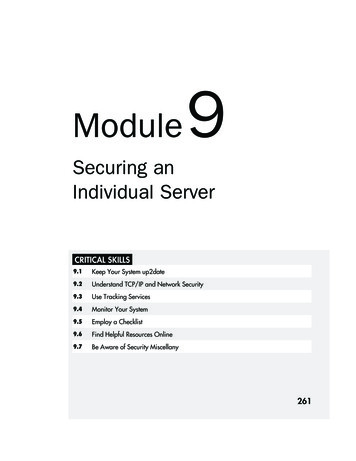
Transcription
The Beginner’s Guide to TaxablePortfolio OptimizationMike KnezevichNorthfieldHigh Net Worth SeminarJanuary 20081
Overviewz Taxable portfolio optimization methodologyz Guidelines for sensible inputsz Troubleshooting “unintuitive” answersz “Tricks” for special casesz Its not black magic, its using common sense2
Optimization Objective Functionz Investor objective is to maximize risk- adjusted returnsnet of costs:U α – ((σs2 / RAPs) – (σu2 / RAPu)) - ((C T) * A)ReturnRisk ComponentImplementation Cost– Most commercial portfolio optimizers uses the objective function described inLevy and Markowitz (1979).– Portfolio return variance is the proper measure of risk because the differencebetween the arithmetic average rate of return and the geometric average rate ofreturn is proportional to the variance (see Messmore, 1995)3
Objective Function Explainedz U α – (σs2 / RAPs) – (σu2 / RAPu) - ((C T) * A) α the “certainty equivalent” expected portfolio return σs2 portfolio variance risk due to common factors (correlationacross securities) σu2 portfolio variance risk due to stock specific risks RAP risk tolerance C transaction costs for the optimization T capital gain taxes for the optimization A amortization constantItems in bold are what user’s have responsibility to set sensibly4
Constraintsz Any optimization can be run with a variety of constraintsz Constraint misuse is the largest contributor to failedoptimizationsz Class I constraints are those that are linear combinations ofsecurity weights:– Position limits– Industry and sector limits– Factor Exposure or Penalty File Variablesz Class II constraints are other constraints such as:––––5Maximum number of assetsMaximum turnoverMinimum trade sizesMaximum realized capital gain
Constraint Feasibilityz If there are conflicts among the constraints, the portfoliooptimization is called “infeasible”z Our system will try to find a reasonable solution toinfeasible problems but this does not mean that you canalways get an intuitive resultz Consider the portfolio construction:– Max number of assets equal to 20– Maximum weight in a position is 4%– Sometimes conflicts are very subtle and hard to notice6
Optimization in Stepsz First, the optimizer attempts to find a portfolio that meets all Class Iconstraints, if one exists– Next it will find the feasible portfolio that has the least turnover fromthe initial portfolio. This is the real starting point of the processz Once a feasible portfolio is found, the main optimization occurs.– Our goal is to adjust the security weights to maximize the objectivefunction, given your input settingsz Violations of Class II constraints are checked when maximum utilityis achievedz If there are any violations of Class II constraints that can be fixed,the optimizer will adjust the security weights to fix themz You’re done7
Stopping Criteriaz The optimization process normally stops when themaximum of the objective function is reached within acertain level of “precision”z Constraint conflicts can cause the process to stopprematurely– Imagine a concentrated portfolio where sector constraintsrequire 65% two way turnover to be feasible. If you set aturnover constraint below 65% you won’t get the fully correctanswer. It can’t be done.– Same concentrated portfolio but where almost all the positionshave embedded capital gains. If you set a “Max RealizedCapital Gain constraint” equal to something small (say zero), itsnot possible and the process will stop prematurely8
Constraint Priorityz If there are conflicts among the constraints, the optimizer will tryto come up with a reasonable compromise– Class I constraints have priority over Class II constraints that are not“stopping criteria”– Within Class I constraints, position sizes are higher than groupingconstraints, that are in turn higher than factor/penalty constraints– There is no specific priority among Class II constraints, so theoptimizer tries to find the best compromise based on the objectivefunction inputs– Constraints on stopping criteria can cause premature termination andunintuitive results– Class II constraints can be violated if they drive the portfolio very faraway from the unconstrained optimal state9
“Pilot Error” Issuesz Most support issues related to optimizations are setupsthat are either mathematically impossible (infeasible) oreconomically irrational, or both.– The Northfield optimizer basic system has been in use byhundreds of institutions since 1989– The tax functionality was added in 1996, and has also beenused by hundreds of institutions for tens of thousands ofportfolios– If you get a weird answer, its probably not a bug in the systemz Review the “Messages” tab output report after everyrun– Any unusual aspects of the problem will result in warningmessages in this report10
Feasible but Economically Irrationalz Users are responsible for setting reasonable inputsfor three aspects of the problem– Certainty equivalent expected returns (CEER), considerboth expectations and probability of being correct– RAP, the investor’s willingness to exchange variance riskand return.z This can be subdivided into common factor risks and stockspecific risks.– Amortization constant, defining the horizon over which costs(trading costs and taxes) that occur at a moment in time arespread into costs per unit time (i.e. reduction in return)11
CEER & RAPReturnSlope 1/RAPCEER1 CEER0 Risk/RAPWhere CEER0 is risk freeCEERRisk12
Expected Return Scalingz Index portfolio, CEER 0 Risk minimizationz Active portfolio, scale benchmark-relative return expectations toreflect your probability of being correctz Assume:– You believe IBM will outperform the market by 30% in the next sixmonths. You don’t know what IBM will do after that– You try to run your portfolios with 25% a year turnover– When you make predictions of stock relative performance, you get thesign right 55% of the time and get it wrong 45%– What’s your CEER?z There is a huge finance literature on alpha scaling that involvessubtleties that are strategy dependent– Northfield will introduce an “automatic” alpha scaling tool to theoptimization system13
Quantifying Risk Tolerance as RAPz RAP is the investor’s willingness to trade between risk and returnz Assuming CEER return scaling, rational values are in the range of 0 RAP 200– Zero would represent a totally risk averse investor (hide the moneyunder the mattress)– 200 represents an investor that only cares about maximizing long termgrowth between now and the end of timez Two good rules of thumb for high net worth investors– In absolute risk terms, RAP approximately 2 times investor’s net worthas a percentage of total assets. This will vary over the investor life cycle– In benchmark relative terms, RAP approximately 6 times the desiredtracking error– Note that these values are what are sensible for investors; they don’tnecessarily express an asset manager’s desire to not get fired14
Cost Amortization Constantsz A good starting value for the amortization constant is thepercentage expected annual “one way” turnoverz Adjust for:– Time value of money. Deferring costs is more valuable when rates ofreturn are high– Possibility of stepped up basis at death. If you’re 99 years old, youdon’t want to pay any capital gains now– The incremental tax on short term gains over long term gains is alwaysspread over the “remaining time to long term status”z Later in 2007, Northfield will introduce a change in the amortizationconstant process that corrects for the traditional Markowitzassumption that the future is one long period.– Performance measurement services and the IRS don’t agree15
Concentrated Positionsz Set the optimizer “non linear transaction cost” function “ON”– This makes the optimizer do transactions in small bites that betterdiversify concentrated positions, rather than a few big tradesz Carefully consider any constraints on maximum tracking error(risk), or maximum realized capital gain– Its very easy to be so risk averse that you spend so much in taxesthat its crazy– Its also very easy to say “optimize the portfolio subject to a maxcapital gain of X”. Clients often do this without understanding thereal economic tradeoffs that are implied.16
“Stupid Optimizer Tricks”z Negative tax rates are not allowed– To realize gains, adjust the position cost basis so gainsbecome losses and losses become gains.z High net worth investors usually care about bothabsolute risk and benchmark relative risk– You can express both by mixing cash into the benchmark. Ifthe client is twice as worried about absolute risk and return,make the benchmark 2/3 cash and 1/3 your regular benchmarkindex17
“Stupid Optimizer Tricks” cont.z If you use CEER values, you can adjust them toreflect taxes on dividends.– Assume a stock that has an expected benchmark relativereturn of zero on a pretax basis, but a dividend yield that is2% greater than the benchmark. The after tax expectedreturn is negative.z The opportunity for tax loss harvesting is enhancedwhen you have a higher degree of cross-sectionaldispersion of returns within portfolios– There is a “tax alpha” for stocks that is positively related tovolatility18
Getting Helpz Always review your “Messages” tab report with respect to themathematical feasibility and economic reasonableness of yourcasez Almost all the conceptual issues are in : : InvestmentManagement for Taxable Private Investors by Wilcox, Horvitzand diBartolomeo. Published by CFA Research Institutez Northfield Optimizer Online HELP is very extensivez Northfield’s website, www.northinfo.com has a large set ofsearchable research papers, newsletters and conferencepresentations with related content19
Other Referencesz Levy, H. and H. M. Markowitz. "Approximating Expected Utility By A Function OfMean And Variance," American Economic Review, 1979, v69(3), 308-317.z Messmore, Tom. "Variance Drain," Journal of Portfolio Management, 1995,v21(4), 104-110.z Markowitz, Harry. "Portfolio Selection," Journal of Finance, 1952, v7(1), 77-91.z Idzorek, Thomas. “A Step-by-Step Guide to the Black-Litterman Model”, ZephyrAssociates Working Paper, 2003.z Black, Fischer and Robert Litterman. "Asset Allocation: Combining Investor ViewsWith Market Equilibrium," Journal of Fixed Income, 1991, v1(2), 7-18.z Grinold, Richard C. "Alpha Is Volatility Times IC Times Score," Journal of PortfolioManagement, 1994, v20(4), 9-16.z Bulsing, Mark, James Sefton and Alan Scowcroft, “Understanding Forecasting: AUnified Framework for both Analyst and Strategy Forecasts”, UBS Working Paper,200320
zFirst, the optimizer attempts to find a portfolio that meets all Class I constraints, if one exists - Next it will find the feasible portfolio that has the least turnover from the initial portfolio. This is the real starting point of the process zOnce a feasible portfolio is found, the main optimization occurs.











